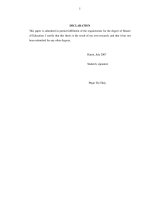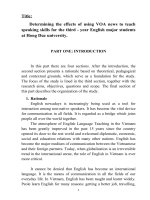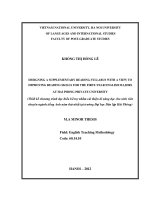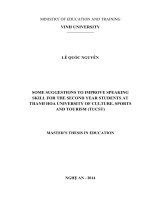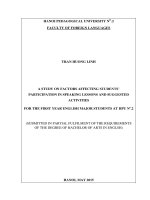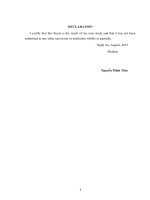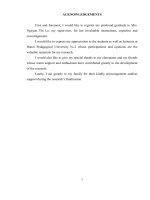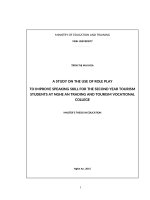Using mind map to improve vocabulary knowledge for the first year english language teaching education students of FLF at HPU2
Bạn đang xem bản rút gọn của tài liệu. Xem và tải ngay bản đầy đủ của tài liệu tại đây (722.67 KB, 61 trang )
HANOI PEDAGOGICAL UNIVERSITY N0.2
FOREIGN LANGUAGE FACULTY
======
DO THI VAN TRANG
USING MIND MAP TO IMPROVE VOCABULARY
KNOWLEDGE FOR THE FIRST YEAR ENGLISH
LANGUAGE TEACHING EDUCATION STUDENTS
OF FLF AT HPU2
(SUBMITED IN PARTIAL FULFILMENT OF THE
REQUIREMENTS OF THE DEGREE OF BACHELOR
OF ARTS IN ENGLISH)
SUPERVISOR: DANG NGOC NAM, M.A
HA NOI, 2016
ACKNOWLEDGEMENTS
This thesis would not have been completed without the support of many
people.
First of all, I want to send my dearest appreciation towards to Mr. Dang
Ngoc Nam, M.A., my supervisor, for his valuable support and encouragement.
My sincere thanks also go to my teachers in the FLF at HPU2 who I owe an
enormous intellectual debt during my years of university work.
I must also not forget to thank my family deeply, for their whole-hearted
care and endless patronage.
i
ABSTRACT
Learning vocabulary is one of the primary emphases to every foreign
leaner where it is always mentioned in the objectives of four skills. This study
was done aiming at investigating the common ways of learning vocabulary and
their difficulties in studying vocabulary ; introducing the mind- map technique
to the first year English Language Teaching Education at HPU2 as well. First, to
learn about the current ways of learning vocabulary, the survey questionnaire
was conducted with 48 students of K41 English Language Teaching Education.
Second, a pre-test
and post-test were done to appreciate the quality of
vocabulary studying among these students before and after the treatment during
five weeks of the second semester of the 2015-2016 academic school year. Last,
the classroom observation also was used to find whether students like the
technique.
Based on the results of these methods, the difficulties of students in
learning vocabulary have been found out as well as MM Technique was
introduced received positive responds from students.
ii
STATEMENT OF AUTHORSHIP
Title: Using Mind Map to Improve Vocabulary for the first year English
Language Teaching Education students of FLF at HPU2.
I certify that no part of this study has been copied or reproduced by me
from any other person’s work without acknowledgements and that the study is
originally written by me under serious guidance from my supervisor.
Date submitted: May 2016
Student
Supervisor
Do Thi Van Trang
Dang Ngoc Nam, M.A.
iii
LIST OF ABBREVIATIONS
FLF
Foreign Language Faculty
HPU2
Hanoi Pedagogical University Number 2
MM
Mind Map
EG
Experiment Group
CG
Control Group
pp.
Pages
iv
LIST OF FIGURES AND TABLES
List of figures:
Figure 1: Human Memory System .................................................................................. 13
Finger 2: Network Tree ...................................................................................................... 15
Figure 3: Event Chain ......................................................................................................... 15
Figure 4: Cycle Concept Map........................................................................................... 17
Figure 5: Spider Concept Map ......................................................................................... 18
Figure 6: Percentage of ―Yes‖ in 5 Weeks .................................................................... 30
Figure 7: Difficulties in learning vocabulary................................................................ 33
Figure 8: Results of the pre-tests in EG ......................................................................... 35
Figure 9: Results of the pre-tests in CG ......................................................................... 36
List of table:
Table 1: Major aspects of vocabulary (Ur, 1996)..................................................................... 11
Table 2: Background information about the students of the research ...................................... 22
Table 3: Planning of the pre-tests and the post-tests ................................................................ 27
Table 4: Results of the Classroom Observation with EG in 5 weeks ....................................... 30
Table 5: Advantages of MM in learning vocabulary................................................................ 34
Table 6: Results of post-tests in EG ......................................................................................... 38
Table 7: Results of post-test in CG........................................................................................... 39
v
TABLE OF CONTENTS
PART ONE
INTRODUCTION
I. RATIONALE FOR THE STUDY .......................................................................................... 1
II. Aim of the study ............................................................................................... 2
III. Scope of the study ........................................................................................... 2
IV. Research Objectives ........................................................................................ 3
V. Methods of the study ........................................................................................ 3
VI. Significance of the study ................................................................................. 3
VII. Research tasks................................................................................................ 3
VIII. Design of the research .................................................................................. 4
PART TWO: DEVELOPMENT
CHAPTER ONE: THEORETICAL BACKGROUND
I.1. Literature review in brief ................................................................................ 5
I.2. An overview of vocabulary............................................................................. 7
I.2.1. Definitions of vocabulary ............................................................................ 7
I.2.2. Types of vocabulary..................................................................................... 9
I.2.3. Aspects of vocabulary ................................................................................ 11
I.2.4. How vocabulary is remembered. ............................................................... 12
I.3. An overview of MM ..................................................................................... 14
I.3.1. Definitions of MM ..................................................................................... 14
I.3.2. Classifications of MM ............................................................................... 14
I.3.3. Dominant of MM ....................................................................................... 18
I.3.4. Using MM to teach vocabulary…………………………………………..20
CHAPTER TWO: METHODOLOGY
II.1. Subject of the study ..................................................................................... 22
II.2. Instruments for the thesis............................................................................. 23
vi
II.2.1. Observation............................................................................................... 23
II.2.2. Survey questionnaire ................................................................................ 24
II.2.3. Tests .......................................................................................................... 25
II.3. Planning ....................................................................................................... 27
II.4. Procedures for Data Collection ................................................................... 28
Conclusion of the Chapter ................................................................................... 29
CHAPTER THREE
FINDINGS AND DISCUSSION
III.1. Findings of the Observation ....................................................................... 30
III.2. Findings of the Questionnaire .................................................................... 31
III.3. Findings of Tests ........................................................................................ 35
PART THREE
CONCLUSION
I. Conclusion ....................................................................................................... 41
II. Limitations and suggestions for further study ................................................ 42
II.1 Limitations .................................................................................................... 42
II.2 Suggestions for further study ....................................................................... 42
References ........................................................................................................... 44
APPENDIX A: CLASSROOM OBSERVATION SHEET
APPENDIX B: SURVEY QUESTIONNAIRE
vii
PART ONE
INTRODUCTION
I. Rationale for the study
The basic purpose of the language is to get an idea out of one brain into
another. A question is raised how people can communicate with others
effectively if they do not use the same language. Therefore, people from
different nationalities want to communicate, they commonly use English
language. That is the reason why it is called ―language of communication‖ or
―language of the world‖.
English, nowadays, is spoken as the first language by nearly 400 million
people and as the second language by 1.6 million people. As its popularity, our
education system attaches special importance to teaching and learning English in
many school levels from primary to university or higher education one. A plenty
of programs and methods were introduced aiming at raising Vietnamese’s
English skills.
It cannot be denied that vocabulary knowledge is a significant factor when
studying any second language. D. A Wilkins, a famous linguist, stated that
without grammar, very little can be conveyed; without vocabulary, nothing can
be conveyed. With rich vocabulary, learners could improve their four English
skills as well as comprehension and production in English. So, learning
vocabulary is always one of the most concerned of English learners.
In fact, the first year students in FLF at HPU2 said that they confuse in
finding ways to improve their vocabulary. They realized that it is not easy to
deal with new words or how to use a word in a sentence. In addition, it is hard
for them to remember these new words for a long time. Consequently, their
vocabulary knowledge is not rich enough to associate with many other problems
in studying English process.
1
Teaching methods also play a significant role to help students improve
their English skills. In lectures of FLF at HPU2, teachers always try to bring
their students various ways to improve their English. However, some methods
are out of fashion for students. Hence, how to improve vocabulary is still a big
problem need solving.
For all reasons listed above with my own enthusiasm in vocabulary, I
would decide to choose Using Mind Map to Improve Vocabulary Knowledge
for the first year English Language Teaching Education students of FLF at
HPU2 as the title of my thesis.
II. Aim of the study
The purpose of this thesis is finding more effective methods to improve
vocabulary knowledge for students of FLF at HPU2. In detail, the primary aim
of the study was set up as follows: To test the usefulness of MM techniques in
improving vocabulary for students of FLF at HPU2;To investigate the
experimental students’ attitudes towards learning vocabulary through applying
MM Technique.
III. Scope of the study
The general research area of this study is vocabulary.
The phenomenon is strategies for enriching vocabulary by using MM
Technique for the first year English Language Teaching Education students of
FLF at HPU2 in the academic year of 2015-2016. Other aspects of vocabulary
and MM Technique are also mentioned.
The participants involved in the study are forty eight K41A English
Language Teaching Education students at HPU2.
2
IV. Research Questions
1. How are the attitudes of students with the MM Technique in class?
2. How effectively is MM used to teach vocabulary to the first year English
Language Teaching Education students at HPU2?
V. Methods of the study
Both qualitative and quantitative methods are used and the data analysis is
collected in the study from many different resources as follows:
Survey questionnaire was designed for collecting data from the first year
English Language Teaching Education at HPU2.
Observation was used as a consideration to observe the student’s attitudes.
Tests for students (pre-test and post-test): these tests helped researcher
associate the improvement of students before and after using MM Technique.
VI. Significance of the study
The thesis was conducted to bring out an overlook on learning vocabulary
statement of the first year English Language Teaching Education at HPU2 as
well as the importance of vocabulary. Moreover, it shows advantages of using
MM Technique in increasing vocabulary. The finding of the study is believed to
be useful for both students and teachers in solving vocabulary problems. In
addition, the study is also useful source of material for anyone who is interested
in enriching vocabulary and MM Technique.
VII. Researcher tasks
The study brings benefits for both teachers and students in terms of
English language as following ways:
3
Students: they can themselves make MM for learning vocabulary
effectively and feel enthusiastic about it. MM Technique encourages them to
enrich their vocabulary knowledge.
Teachers: Teachers may have one more technique to vary their teaching
techniques and they also can help their students fix their vocabulary difficulties.
Readers: Like students, readers can get more knowledge about MM
Technique as well as find a new way to enrich their vocabulary for studying a
second language.
VIII. Design of the research
The research includes three main parts: Introduction, Development and
Conclusion.
Part 1: ―Introduction‖ is about all primary knowledge required for an
essay namely rationale for the study, research presupposition, research
objectives, research scope, research methods, research tasks, design of the
research work.
Part 2: ―Development‖ consists of three main chapters. Chapter 1 entitled
―Theoretical background‖ that deal with things about literature review, an
overview of vocabulary and an overview of MM Technique. While, the second
chapter covers all about the methodology used in the research. The last chapter
in this part is Finding and Discussion. It deals with data collected from the
surveys above and then gives the reality and some suggested solutions of
applying MM Technique as a way of learning vocabulary.
Part 3: ―Conclusion‖ is mentioned with limitations of the study as well as
some suggested solutions for further study.
4
PART TWO: DEVELOPMENT
CHAPTER ONE
THEORETICAL BACKGROUND
I.1. Literature Review in Brief
Oxford (1990) stated that the word ―strategy‖ ‖ originated from an ancient
Greek term ―strategia‖ which meant generalship or the art of war. Accordingly,
it indicated the management of the troops, ships, or aircraft in a war situation.
She also expanded on this definition by saying that: ―Learning strategies are
specific actions taken by the learner to make learning easier, faster, more
enjoyable, more self-directed, more effective, and more transferrable to new
situation‖ (pp.45-48).
Teachers often use various strategies to facilitate vocabulary acquisition.
For example, they may present clear explanations and synonyms of the words,
or use role-plays or multi-media to increase exposure. The connection between
vocabulary learning strategies and learning outcomes have been shown (Gu,
2010) and researchers have studied the nature of the former in this connection.
Meanwhile, students often use repetition as an important step for
vocabulary acquisition (Ellis and Beaton, 1993). However, learning vocabulary
by reciting words is painful and not effective (Li, Yang and Chen, 2010). To
enhance the effectiveness of learning, students have to be trained about memory
strategies and encouraged to use them during the process of learning.
MM which contains different colors, images, symbols and errors can be
used in many learning and thinking processes. It is more fully explained in part
I.3.
First of all, according to Boyson (2009), Using MM for lesson planning
can help teachers find out a logical plan or teaching route and increase recall of
5
the subject matter. Then, it can boost teaching confidence and facilitate the
smooth running of programs.
Moreover, as illustrated by Buzan (1976), the drawing of MM requires
the use of both sides of the brain and therefore can increase productivity and
memory retention. The strong visual appeal of MM can speed up the learning
process and help students to memorize and recall information effectively
(Brinkman, 2003). Also, the more personalized the MM is, the easier the learner
could retrieve information (Buzan and Buzan, 2000).
Besides, Li, Yang and Chen (2010) declared that MM were commonly
used for note taking, creative thinking, report writing and decision making. In
Taiwan, since 2002, numerous journal papers have been published in support of
the positive effects of using MM in teaching and learning at school. Through
MM, children develop their ―personalized‖ maps with pictures and colorful lines
that stimulate their interests and creativity and consequently their competences
in reading and writing. Especially, MM is useful for the building of knowledge
and understanding, ideas association and vocabulary learning.
In additions, Goodnough and Long (2002) stated MM to be a useful
technique for introducing new concepts, providing a whole-class focus for a
large research project, assessing learning of individuals and offering greater
choice in how people chose to complete assignments and projects.
Holland, B., Holland, L. and Davies, J. (2003/2004) claimed that MM was
useful for helping people plan and structure projects and assignments more
effectively. The experimental subjects in this study were able to improve the
structure, coherence and, as a result, the quality of their written work and draw
value from the technique for project managing practical work. Furthermore,
Mento, A.J., Martinnelli, P. and Jones, R.M. (1999) affirmed that MM was a
powerful cognitive tool which could be used in a variety of ways because of its
ability to create associative thinking.
6
Finally, as stated by Rivers (2002) vocabulary could not be taught, but it
could be presented, explained, included in all kinds of activities and experienced
in all manner of association. MM was regarded as a significant tool which could
be used in teaching vocabulary as well as enables for learners to memorize
vocabulary easily.
I.2. An Overview of Vocabulary
I.2.1. Definitions of vocabulary
Vocabulary is an important factor to learn English that can have the great
influence on the process of learning English. The richer vocabulary knowledge
of learner is, the easier they can communicate and express their ideas to others.
English has a very large, estimated to between 450,000 and 750,000 words
(Stahl, 1999 and Tompkins, 2005). In addition, with the development of human
society, the number of vocabulary is higher and higher day by day.
Regarding vocabulary, agreement on its definition seems to be difficult as
each scholar and linguist or even each English learner has his own set of ideas to
come up with the precise definition of vocabulary. Thus, there have been many
differences in defining it.
According to Cambridge Advanced Learner’s Dictionary Online, vocabulary
is defined as a) all the words that a person knows or uses, b) all the words in a
particular language, c) the words that people use when they are talking about a
particular subject and d) a list of words with their meanings, especially in a book
for learning a foreign language.
Richard (2002) defined in his book ―Longman dictionary of language
teaching and applied linguistic‖ (p.580) that vocabulary was a set of Lexemes,
including single words, compound words and idioms.
7
Hornby (1974) said that vocabulary was (1) the total number of words that
make up a language (2) body of words knows to a person or used particular
book subject (3) list of words with their meaning.
From all the above discussions about vocabulary, there is also a need to
elaborate word. Word is a single unit of language which means something and
can be spoken or written (Oxford Advanced Learner’s Dictionary). Regarding
the connection of words and vocabulary, McCarthy (1995) also asserted
that―[…] when we speak of the vocabulary of a language, we are speaking
primarily, but not exclusively, of the word of that language […]‖ (p.3)
Therefore, it can be understood simply that a word is one part of a
vocabulary.
In conclusion, there are numerous ways to understand the concept of
―vocabulary‖. Besides, here arises the problem of whether ―words‖ and
―vocabulary‖ has the same indication. In this paper, there is no difference in use
between ―words‖ and ―vocabulary‖ to refer to all the words that existed in a
language, which can transmit and express ideas. However, when ―word‖ is used,
it refers to a single word only as the smallest unit of language to convey ideas.
A beginning student who is good at English may know about twice as many
words as others. Generally, this gap does not tighten. Following Wikipedia
(2001) this translates into a wide range of vocabulary size by age five or six, at
which time an English-speaking child will know about 2500-5000 words. An
average student learns some 3000 words per year, or approximately eight words
per day.
After leaving school, vocabulary growth reaches a plateau. People may then
enrich their vocabulary by engaging in activities such as reading, playing word
game or even themselves create new words to meet their demand.
To sum up, it is clear enough that everybody learning a language as a foreign
language expects to know and master the vocabulary to improve the language
8
skills. So when someone interests to learn a foreign language they must master
at vocabulary, because in all language aspects vocabulary is needed. Shortage of
vocabulary becomes a major problem in learning English especially to English
university students, when they have good ability in mastering vocabulary, they
will be easier in mastering any aspect of English.
I.2.2. Types of Vocabulary
Vocabulary development is a critical aspect of teaching, especially in
classes or schools with high populations of English leaner. Differentiating
between the types of vocabulary can help teachers decide how much effort to
put into teaching particular vocabulary words, as well as which strategies will be
the most effective when teaching the words.
First and foremost, Harmer (1991) divided vocabulary into two types,
they are:
a. Active vocabulary refers to vocabulary that has been learned by students. They
are expected to be able to use it.
b. Passive vocabulary refers to word which the students will recognize when they
meet them but which they will probably not able to produce.
On the other hand, basing on the information from Wapedia (http://
wapedia.mobi/ en/ Vocabulary) there are four types of vocabulary:
a. Reading Vocabulary: A person’s reading vocabulary is all words they can learn
when reading. This is the largest type of vocabulary simply because it concludes
the other three.
b. Listening Vocabulary: That is all words we can recognize when listening to
speech. This vocabulary is aided in size by context and tone of voice.
c. Speaking Vocabulary: It is all the vocabulary that learners can use in speech.
Due to the spontaneous nature of the speaking vocabulary, words are often
misused. This misuse – though slight and unintentional – may be compensated
by facial expressions, tone of voice, or hand gestures.
9
d. Writing Vocabulary: A learner’s writing vocabulary is words which he or she
can employ in writing. Contrary to the Listening and Reading Vocabulary types,
this one is stimulated by its user.
In addition, Stephen Lauber mentioned some types of vocabulary in
Classroom Strategy (2014). Following his point, there were three different kinds
of vocabulary: Academic Vocabulary, Content Vocabulary and Support
Vocabulary.
First, academic vocabulary can be defined as words that are not tied to
any particular course or content area. These are words that students may be
exposed to during any subject or class, whether it is math or social science.
Typically, these are words that regularly appear in academic texts and tests;
however, Stephen Lauber has found that they are not often explicitly taught.
Academic Vocabulary words often show up as the skill words in learning
objectives, but can occur at any point during a lesson as well. Because of this, it
is more effective way to teach Academic Vocabulary words as they arise, within
the context of a lesson.
Second, contrasted with Academic Vocabulary, Content Vocabulary
includes words that are specific to a given domain or subject area, rarely being
found outside of their particular content area. Often, these words can be found
directly in the content standards and are presented as the concept words
(typically nouns) in a Learning Objective. Content Vocabulary words are
addressed extensively in the Concept Development of a lesson, through the use
of clear definitions, examples, and Checking For Understanding questions, as
these words and terms are frequently the foundation of a lesson.
The third, and final, type of vocabulary (as identified by DataWORKS) is
Support Vocabulary. Support Vocabulary consists of any remaining words that
students need to know in order to understand a particular sentence or phrase
used in a lesson. Support Vocabulary words are unrelated to grade-level
10
concepts and skills and can typically be found in reading passages or text. These
words are often not critical for the success of the lesson, so little time needs to
be spent on teaching Support Vocabulary beyond ensuring that the students
understand any meaning in the context of the lesson.
I.2.3. Aspects of Vocabulary
Basically, before knowing deeper about techniques to teach vocabulary, it
is required to define clearly the matter of what to teach. Following Richards
(1976), knowing a word involves knowing 1) a great deal about its general
frequency of use, syntactic and situational limitation on its use, 2) its underlying
form and forms that can be derived from it, 3) the network of its semantic
features and 4) the various meanings associated with the item.
Categories
Form
Grammar
Aspects
meaning
Pronunciation
Spelling
of Collocation
Denotation
Connotation
Formality
Synonym
Anonym
Hyponym
Word building
Discription
What a word sound like.
What a word look like.
Change of forms
Restriction or how words can
be together.
The core meaning that refers
to the word to the real world.
The additional meaning that
shows people’s emotions and
attitudes towards what the
word refer.
Example
[ti:]
Tea
Do-> Doing
―Make mistake‖ but ―Do
wrong‖
Nightfall: the close of the
day.
―Excuse‖ in ―She made an
excuse for being late has a
negative meaning‖.
Whether the
word is
appropriate to use in certain
context.
Words that mean the same or
nearly the same
Words that mean the
opposite
Words that serve specific
examples of the same
concept.
How a word is created
Thanks versus Thank you
Keen on versus Interested
in
Happy versus Unhappy
Ruler, Book, Erase, Pencil
->School things
Ultra-modern, super- hero
Table 1: Major aspects of vocabulary (Ur, 1996)
11
Table 1 is to describe the major aspects of vocabulary that can be taught to
students by Ur (1996) adapted in ELT Methodology II Course Book and
Recommended Readings. Those divisions of vocabulary by Ur cover all aspects
presented by other scholars.
Therefore, knowing a word does not just simply know its equivalent in one’s
mother tongue but there are a lot of aspects to cover. It is not easy for teachers to
teach new words and provide as many aspects as possible. Similarly, students
also find that it is difficult to build up their own vocabulary with the sufficient
perception of all aspects. But after all, the important in learning vocabulary is
not only learning its meaning, but also remembering it and then using it as well.
I.2.4. How vocabulary is remembered.
Following Schmitt and Schmitt (2010), there were two types of
mental process relating to remember a word: dicovering the meaning of this new
word; then using and memorising this one.Therefore, it should be noted that
there is a distance from knowing a word to remembering a word.
Then, it is essential in teaching vocabulary to know how it is learned. If
teachers do not know the process of storing words in learners’ mind, they will
not be able to have positive impacts in need to help learners with words.
Moreover, how vocabulary is learned and remembered are different but
related because how word is learned has great influence on how it is
remembered. For example, a good presentation of a word will help learners
remember it more easily and use it more effectively as words are put in
visualized presentation and in contexts (Do, 2009).
For that all reasons above,not only students, every teacher should find out
an effective method to teach vocabulary and help student remember word better.
Reinitz (2010) said that the goal of memory was to leave people with a
coherent story of what happened. Memorising was a very complex
12
psychological process. It was a dynamic system, involving three interconnected
memory stores ( Dr. Drew Appleby from Indiana University)
Figure 1: Human Memory System (Hedge, 2010)
The diagram is to describe the operation of human memory system.
Firstly, the information received from our senses is initially stored in sensory
memory or short-term memory. Although information is retained in sensory
memory for less than two seconds, which is long enough for us to interpret it
and to decide which parts of it are important enough to pay attention to and
transfer to working memory, where we can continue to process it. Then, the
information stays in working memory for about thirty seconds only unless we
continue to maintain them by repeating them to ourselves. When there is too
much information transfered from short-term memory, it is overloaded and
forgetting will occur in working memory. Finally, every learner hopes to
remember information longer and longer, in another way, we need to bring them
to long-term memory. Understanding the memorable process above, we all
know that to remember things better, we need to bring them to long-term
memory. But how to do that? How to present information well is a great
question that needs solving.
13
In term of learning new words, the way to learn them is still being a
challenging to both students and teachers. We should find out a technique that
can help us record not only the words but also the way we learned the word.
I.3. An Overview of MM
I.3.1. Definitions of MM
MM is a powerful technique that expresses information in diagrams
instead of writing it in sentences. The diagram may use a lot of different colors,
shapes, images, symbols, numbers or lines. It often takes the same basic format
of a tree with a single starting point in the middle that branches out then divides
again and again.
The term MM was first introduced by British popular psychology author
and television personality Tony Buzan in the lately 1960s. Nowadays, it is used
by millions of people in all over the world- from the very young to the very old
who wish to use their mind more effectively. MM is suitable for all types of
learners with different levels because there is no limit to the number of ideas,
connections or thought made by learners. In addition, MM can be drawn by
hand, either by ―rough notes‖ during the lecture or even higher quality pictures
when learner has enough time. It is also considered to be a type of spider
diagram or a similar concept in the 1970s was ―idea sun bursting‖.
I.3.2. Classifications of MM
Trianto (2009) distinguished four kinds of MM, namely: (1) network tree,
(2) event chain, (3) cycle concept map, and (4) spider concept map.
14
I.3.2.1. Network tree
The network tree starts with one item – centre word that branches into two
or more, each of which branch into two or more, so on. It looks like a tree, with
trunk and multiple branches.
Network tree is often used to divide big categories into smaller and
smaller ones. Using network tree help learners think step by step from
generalities to specifics.
Finger 2: Network Tree
I.3.2.2. Event chain
Figure 3: Event Chain
15
Event chain is visualization that shows the relationships between events
and tasks and how the events affect each other.
It can be used for giving an accident order, steps in a procedure, or steps in a
process. It is suitable for visualization (a) some steps in a process, (b) some steps
in a liner procedure, and (c) an accident order.
16
I.3.2.3. Cycle concept map
Cycle concept map is a graphical tool for organizing and representing
knowledge in a circles or boxes. On the other hand, it is suitable to show a
correlation how a combination is interacting to produce a group of result
repeatedly which has no final result.
Figure 4: Cycle Concept Map
I.3.2.4. Spider concept map
Spider diagrams organized in a neat and clearly structured layout are
mainly used for planning (eg. an article or story) or creating and provoking
ideas. The biggest advantage of using this structure is that you have to think
about where you are going to position your ideas in relation to the central topic
and the other ideas you are considering.
17
